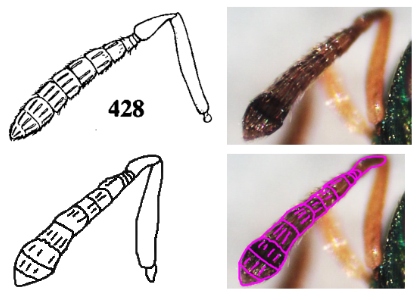Diptera.info :: Identification queries :: Other insects, spiders, etc.
|
Pteromalidae ?
|
|
| Ray Perry |
Posted on 28-09-2017 03:57
|
|
Member Location: Flensburg, Germany. Posts: 592 Joined: 26.09.17 |
ID please? Size: 2-3mm. Observed: 15.05pm, 18 Sept 2017, Flensburg, Germany. Habitat. Vegetable garden Feeding on carrot blossoms Ray Perry attached the following image:  [121.77Kb] |
|
|
|
| Ray Perry |
Posted on 28-09-2017 03:59
|
|
Member Location: Flensburg, Germany. Posts: 592 Joined: 26.09.17 |
You Tube videos:- https://www.youtu...DVOzrJRLqU https://www.youtu...JZNz5vI1TE https://www.youtu...9PrTwQObAs Edited by Ray Perry on 02-10-2017 10:05 |
|
|
|
| crex |
Posted on 28-09-2017 06:13
|
|
Member Location: Sweden Posts: 1996 Joined: 22.05.06 |
Select and mark the YouTube URL and press the YouTube button. The URL should then be surrounded by the tags. |
|
|
|
| Ray Perry |
Posted on 28-09-2017 10:21
|
|
Member Location: Flensburg, Germany. Posts: 592 Joined: 26.09.17 |
Thanks |
|
|
|
| johnes81 |
Posted on 28-09-2017 11:11
|
|
Member Location: Berlin, Germany Posts: 1980 Joined: 15.10.16 |
Pteromalidae looks to be correct but looks can be deceiving with Chalcidoidea. I study Chalcidoidea because I like them. I only know of Hannes Baur (Naturhistorisches Museum der Burgergemeinde Bern) to be an expert. One cannot possibly see enough details from a photo or video to place it in a genus because the antennae (mostly clava and anneli) and clypeus are not visible. In order to key a Chalcidoidea, one needs to be able to see at minimum the antennae and the clypeus through a microscope. Central Europe still has undescribed species (vide two new species of Pteromalus from Central Europe by Hannes Baur.) I have identified a few so far but it is very difficult even with a specimen. vide my attachment. I have to outline the antennae sometimes to identify a species. The attachment contains my identification of Meraporus graminicola. The top-left image is from a pdf file with keys. The bottm left and right images are my outlines of the antennae captured using a microscope. The top-right image is the actual antennae used in the outline. very difficult-to-impossible for id without a specimen. johnes81 attached the following image:  [47.85Kb] Edited by johnes81 on 28-09-2017 11:43 John and Nini. Naturalists not experts. |
|
|
|
| Ray Perry |
Posted on 02-10-2017 11:02
|
|
Member Location: Flensburg, Germany. Posts: 592 Joined: 26.09.17 |
Thanks Johnas, I'm a real amateur, have only started looking closely at insects this year and am absolutely amazed at the variety just in my back yard... and the smaller the insects the more variety there seems to be. I can certainly appreciate the difficulty in identifying these tiny creatures and understand why so many species still need recording. It must be a fascinating field of study. I was a geologist in my younger days and the variety of minerals we had to know is minuscule compared to what I should imagine entomologists are faced with. This could be Meraporus graminicola but the antennae do not seem to have that bulge at the end. I included more videos at the top and here is another taken on 21st Sept. It's in slow motion to reduce the judder. https://www.youtu...0MHneO1BaA I have also posted images and the video of a green Chalcidoidea which I only saw on one occasion:- https://diptera.i...ost_341033 Warm regards Ray |
|
|
|
| Jump to Forum: |












